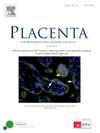胎儿炎症反应综合征与急性胎盘炎症分期之间的关系由存在或不存在胎膜早破分层
IF 3
2区 医学
Q2 DEVELOPMENTAL BIOLOGY
引用次数: 0
摘要
胎儿炎症反应综合征(FIRS)是一种与新生儿发病率和死亡率增加相关的危重疾病,与出生时胎龄无关。本研究旨在确定FIRS在急性胎盘炎症的每个阶段的频率,并根据是否存在早产胎膜早破(PPROM)进行分层。方法本研究纳入自然早产的单胎孕妇。胎儿炎症反应综合征定义为脐带静脉白介素-6浓度11.0 pg/mL。根据阿姆斯特丹胎盘研讨会小组共识声明的定义,急性胎盘炎症分期分为母体炎症反应(MIR)和胎儿炎症反应(FIR)。结果584例孕妇符合纳入标准,其中有PPROM 300例,无PPROM 284例。MIR期对FIRS的预测能力高于FIR期,受试者工作特征曲线下面积分别为0.85和0.80 (P = 0.05)。PPROM患者的FIRS发生率在无MIR期和MIR期1、2、3期分别为5%、64%、75%和71%;在没有PPROM的患者中,频率分别为7%,26%,40%和81%。MIR 1期和2期PPROM患者发生FIRS的频率显著高于无PPROM患者(18/28 vs 6/23, P = 0.01;18/24 vs. 6/15, P = 0.04)。这些结果表明,在基于胎盘病理预测FIRS时,考虑MIR分期和PPROM存在与否的重要性。本文章由计算机程序翻译,如有差异,请以英文原文为准。
Relationship between fetal inflammatory response syndrome and stages of acute placental inflammation stratified by the presence or absence of preterm premature rupture of membranes
Introduction
Fetal inflammatory response syndrome (FIRS) is a critical condition associated with increased neonatal morbidity and mortality, regardless of gestational age at birth. This study aimed to determine the frequency of FIRS at each stage of acute placental inflammation, stratified by the presence or absence of preterm premature rupture of membranes (PPROM).
Methods
This study included singleton pregnant women with spontaneous preterm births. Fetal inflammatory response syndrome was defined as an umbilical cord vein interleukin-6 concentration of >11.0 pg/mL. Stages of acute placental inflammation were categorized into maternal inflammatory response (MIR) and fetal inflammatory response (FIR), as defined by the Amsterdam Placental Workshop Group Consensus Statement.
Results
In total, 584 pregnant women (300 with PPROM and 284 without PPROM) met the inclusion criteria. Predictive ability of the MIR stage for FIRS was higher than that of the FIR stage, with area under the receiver operating characteristic curve values of 0.85 and 0.80, respectively (P = 0.05). Frequencies of FIRS in patients with PPROM were 5 %, 64 %, 75 %, and 71 % for no MIR and MIR stages 1, 2, and 3, respectively; in patients without PPROM, the frequencies were 7 %, 26 %, 40 %, and 81 %, respectively. The frequency of FIRS was significantly higher in patients with PPROM than that in those without PPROM at MIR stages 1 and 2 (18/28 vs. 6/23, P = 0.01; 18/24 vs. 6/15, P = 0.04).
Discussion
These results demonstrate the importance of considering both MIR stage and the presence or absence of PPROM when predicting FIRS based on placental pathology.
求助全文
通过发布文献求助,成功后即可免费获取论文全文。
去求助
来源期刊

Placenta
医学-发育生物学
CiteScore
6.30
自引率
10.50%
发文量
391
审稿时长
78 days
期刊介绍:
Placenta publishes high-quality original articles and invited topical reviews on all aspects of human and animal placentation, and the interactions between the mother, the placenta and fetal development. Topics covered include evolution, development, genetics and epigenetics, stem cells, metabolism, transport, immunology, pathology, pharmacology, cell and molecular biology, and developmental programming. The Editors welcome studies on implantation and the endometrium, comparative placentation, the uterine and umbilical circulations, the relationship between fetal and placental development, clinical aspects of altered placental development or function, the placental membranes, the influence of paternal factors on placental development or function, and the assessment of biomarkers of placental disorders.
 求助内容:
求助内容: 应助结果提醒方式:
应助结果提醒方式:


